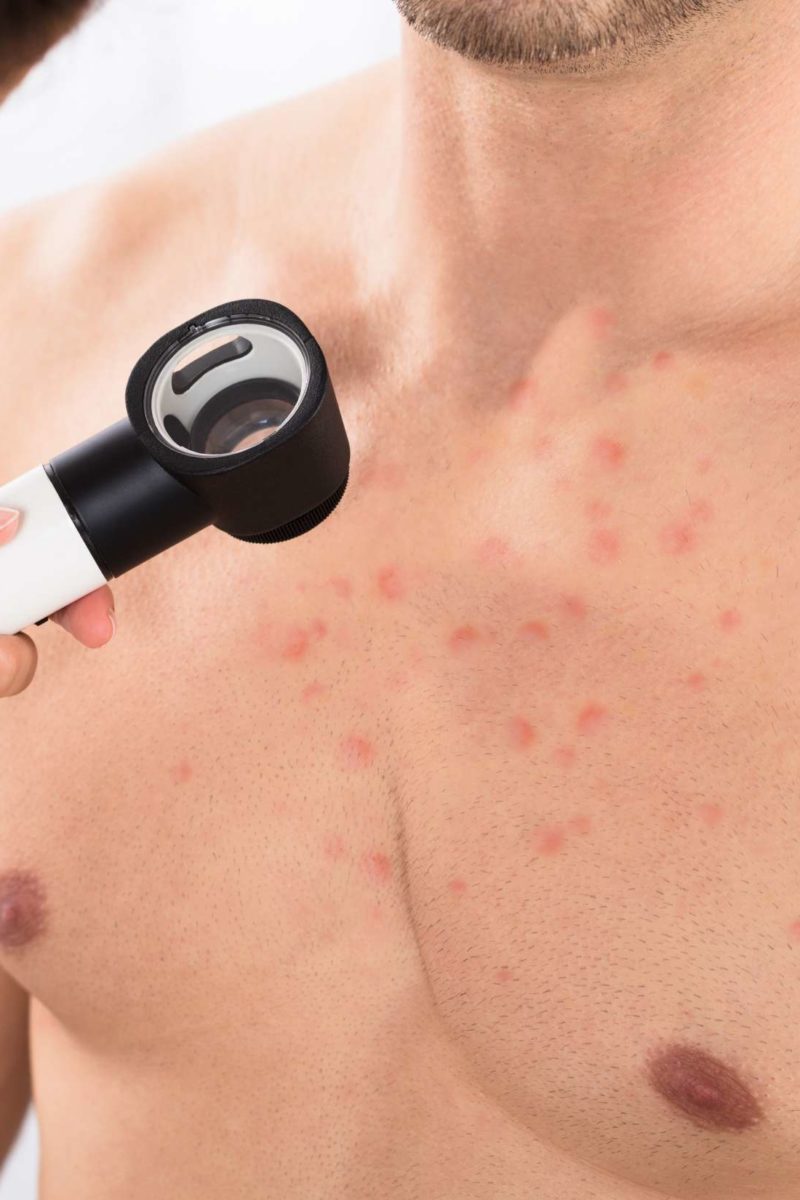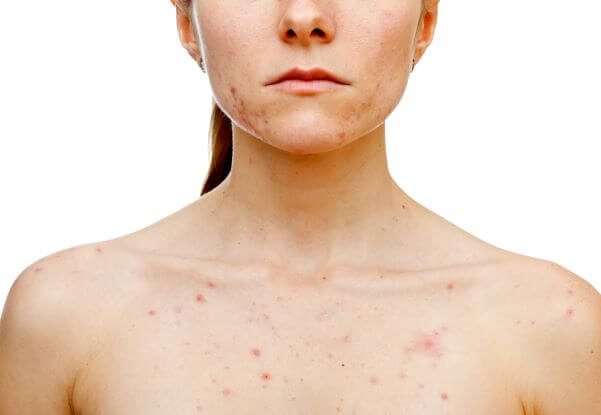Acne is one of the most common chronic skin conditions. In fact, almost everyone will struggle with acne at some point in their life. According to Dr. Arathi Rana of U.S. Dermatology Partners in Sherman and Paris, Texas, “Most people will have mild acne as teens, a lot of women experience acne related to pregnancy, and many people experience acne breakouts when they’re under stress. For most people, acne breakouts and pimples mainly develop on the face, but acne can impact any part of the body, including the chest. Chest acne can be painful, and because the area is usually covered, trapping sweat and oil on the skin, it can be difficult to treat. If you need help getting rid of chest acne, your dermatologist can help.” Learn more from Dr. Rana about how to get rid of chest acne in this blog or by contacting us today.
What Causes Chest Acne?

Chest acne is typically caused by changes in hormones, overproduction of sebum oil, poor skin cell turnover, and other factors that lead to acne on the face.
In addition to these common causes of acne, the following factors may contribute to chest acne breakouts:
- Use of skincare products that trap in moisture (humectants, occlusives, emollients, and other moisturizing products)
- Certain types of clothing can trap oil and moisture against the body, leading to clogged pores, and fabric can rub against the skin causing irritation and inflammation
- Excessive sweating, especially when wearing clothing that doesn’t breathe or traps moisture against the skin
- Application of harsh chemicals from soap, laundry detergents, and other hygiene or cleaning products
- Use of medications like corticosteroids or testosterone that can impact hormone regulation
- Consuming high sugar foods and drinks is often linked to chest acne breakouts
- Dehydration leads to dryer skin, increasing sebum oil production, and the risk for clogged pores
What are the Best Ways to Get Rid of Chest Acne?
According to Dr. Rana, “Identifying and understanding the underlying causes of your chest acne is the first step toward creating an effective acne treatment plan. Once you understand the specific skin care products, stresses, and other issues that lead to flare-ups in your condition, you can take steps to avoid them. From there, you can partner with your dermatologist to create a skin care routine to clear up your current breakout and prevent them in the future.”
Individuals with chest acne should work with their dermatologist to create a personalized skin care plan that works for them, but some steps anyone can take to treat chest acne breakouts include:
- Use antibacterial soap to clean the area around the breakout after sweating or getting dirty
- Swap out your thick, cream-based moisturizers for lotions that are non-comedogenic to help keep your skin moisturized without contributing to breakouts
- Apply topical acne treatments to blemishes
During chest acne breakouts, most people can clear up their pimples using over-the-counter products. Acne body washes, wipes, and spot treatments are available in your local pharmacy to help clear up pimples. Patients who have larger pimples or cysts and nodules that develop deeper beneath the skin should contact their dermatologist for treatment as soon as possible. These more severe forms of acne can be very painful, have a greater risk of infection, and may lead to scarring if not properly treated.
How Can I Prevent Chest Acne from Coming Back?
Dr. Rana says, “Once you have a chest acne breakout under control, you should continue to care for your skin to prevent another one. With a thorough skincare routine and a few minor lifestyle changes, you should be able to prevent or at least reduce the number and severity of acne breakouts.”
Some of the steps individuals can take to prevent chest acne flareups include:
- Bathe regularly (especially after sweating) using gentle cleansers that are free of perfumes and dyes. For best results, use lukewarm water throughout your shower. If you can take the cold, consider a quick, final rinse with cool water at the end of your shower to close your pores.
- Avoid using cleaning or skin care products with perfumes, dyes, or harsh chemicals. Look for products that have fewer ingredients and those that are specifically labeled for use in acne treatment or prevention. Products that contain benzoyl peroxide and salicylic acid are often beneficial to clear up or prevent an acne breakout.
- Exfoliate your skin every week to remove dead skin cells, promote fast cell turnover, and prevent skin cells from clogging pores. Rather than using rough scrubs or abrasive products that can inflame and irritate the skin during an acne breakout, consider using an azelaic or citric acid exfoliant product.
- Limit your intake of high sugar foods that have been linked to more frequent and severe chest acne breakouts.
- Wear clothing that breathes and doesn’t fit tightly over the chest, especially in warm, humid weather.
Visit U.S. Dermatology Partners
If you’re struggling with chronic acne breakouts that don’t respond to at-home care, it’s time to visit with a dermatologist to adjust your daily skin care routine and create a plan to manage breakouts. You should also visit your dermatologist at U.S. Dermatology Partners any time you experience a severe acne flare-up. For deep or infected acne cysts and nodules, your dermatologist can remove the buildup in the clogged pores safely to help you avoid infection and scarring as well as providing treatment to address your acne breakout. When you’re ready to learn more about your treatment options or start creating an acne skincare routine, you can use the simple online scheduling request form to set up an appointment with Dr. Rana or one of the many knowledgeable dermatologists at U.S. Dermatology Partners. Once we hear from you, a team member will be in touch to finalize the details of your first appointment.
Find a location near me
or


